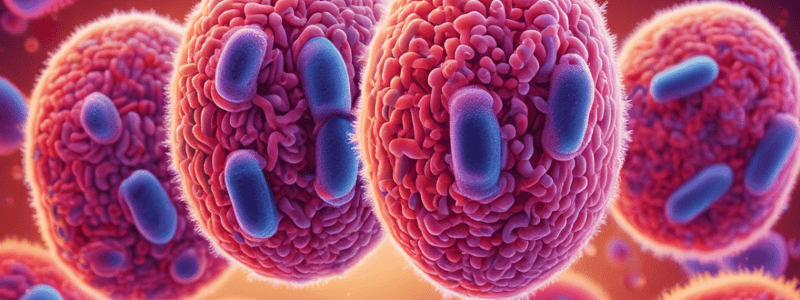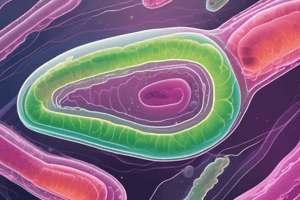Podcast
Questions and Answers
Which bacterium is known to cause syphilis?
Which bacterium is known to cause syphilis?
- vibrio cholera
- Borrelia burgdorferi
- Campylobacter jejuni
- Treponema Pallidium (correct)
What disease is caused by Borrelia recurrentis?
What disease is caused by Borrelia recurrentis?
- Relapsing fever
- Pontiac fever
- Leptospirosis (correct)
- Syphilis
Which organism is responsible for causing relapsing fever?
Which organism is responsible for causing relapsing fever?
- Vibrio cholerae
- Campylobacter jejuni
- Borrelia burgdorferi (correct)
- Borrelia recurrentis
Which bacterium is associated with the disease known as leptospirosis?
Which bacterium is associated with the disease known as leptospirosis?
Which bacterium possesses flagella in bundles called axial filaments?
Which bacterium possesses flagella in bundles called axial filaments?
What is the major virulence factor of Haemophilus influenzae in respiratory infections?
What is the major virulence factor of Haemophilus influenzae in respiratory infections?
Which of the following infections is caused by Haemophilus ducreyi?
Which of the following infections is caused by Haemophilus ducreyi?
In which region of the USA are most cases of tularemia caused by Francisella tularensis reported?
In which region of the USA are most cases of tularemia caused by Francisella tularensis reported?
Which Gram-negative rod is fastidious in culture and requires special media for growth?
Which Gram-negative rod is fastidious in culture and requires special media for growth?
Which virulence factor is common among Gram-negative bacteria such as Pseudomonas aeruginosa, besides the capsule?
Which virulence factor is common among Gram-negative bacteria such as Pseudomonas aeruginosa, besides the capsule?
Which Gram-negative bacterium is known for causing hemolytic uremia syndrome and kidney damage in humans?
Which Gram-negative bacterium is known for causing hemolytic uremia syndrome and kidney damage in humans?
Which Gram-negative bacterium can be treated with antibiotics and is commonly found in soil and feces?
Which Gram-negative bacterium can be treated with antibiotics and is commonly found in soil and feces?
Which Gram-negative bacterium causes wound infections and pneumonia, with its capsule being a major virulence factor?
Which Gram-negative bacterium causes wound infections and pneumonia, with its capsule being a major virulence factor?
Which Gram-negative bacterium is a common cause of urinary tract infections and produces urease?
Which Gram-negative bacterium is a common cause of urinary tract infections and produces urease?
Which Gram-negative bacterium is associated with being common in cows, deer, and swine, and can cause diarrhea and kidney damage in humans?
Which Gram-negative bacterium is associated with being common in cows, deer, and swine, and can cause diarrhea and kidney damage in humans?
Which bacterium is known for causing cholera?
Which bacterium is known for causing cholera?
What is a notable feature of spirochetes?
What is a notable feature of spirochetes?
Which bacterium is associated with Lyme disease?
Which bacterium is associated with Lyme disease?
What is a common symptom associated with Campylobacter jejuni infection?
What is a common symptom associated with Campylobacter jejuni infection?
Which bacterium causes relapsing fever transmitted by lice?
Which bacterium causes relapsing fever transmitted by lice?
What is the most common cause of bacterial gastroenteritis?
What is the most common cause of bacterial gastroenteritis?
Which bacterium is known for causing ulcers and gastritis?
Which bacterium is known for causing ulcers and gastritis?
Which bacterium is known for being zoonotic and causing bacterial gastroenteritis?
Which bacterium is known for being zoonotic and causing bacterial gastroenteritis?
Which bacterium is associated with being the cause of stomach cancer?
Which bacterium is associated with being the cause of stomach cancer?
Which bacterium has flagella and cytotoxin as part of its characteristics?
Which bacterium has flagella and cytotoxin as part of its characteristics?
Which Gram-negative bacteria is known to cause cholera?
Which Gram-negative bacteria is known to cause cholera?
Which pathogen is responsible for causing a relapsing fever transmitted by lice?
Which pathogen is responsible for causing a relapsing fever transmitted by lice?
Which Gram-negative bacterium is associated with causing Lyme disease?
Which Gram-negative bacterium is associated with causing Lyme disease?
Which of the following is a Gram-negative bacterium that can cause gastroenteritis in humans?
Which of the following is a Gram-negative bacterium that can cause gastroenteritis in humans?
Which of the following bacteria is commonly associated with foodborne illnesses?
Which of the following bacteria is commonly associated with foodborne illnesses?
What is the main symptom of food poisoning caused by a large dose of a certain pathogen present on eggs and poultry?
What is the main symptom of food poisoning caused by a large dose of a certain pathogen present on eggs and poultry?
Which pathogen is associated with typhoid fever and spreads through the body, with the gall bladder acting as a reservoir?
Which pathogen is associated with typhoid fever and spreads through the body, with the gall bladder acting as a reservoir?
How is Shigella mainly transmitted to cause infections in humans?
How is Shigella mainly transmitted to cause infections in humans?
Which pathogen produces a toxin that inhibits protein synthesis, leading to increased damage in infected individuals?
Which pathogen produces a toxin that inhibits protein synthesis, leading to increased damage in infected individuals?
What is the most serious consequence of diarrheal diseases like shigellosis caused by S.dysenteriae?
What is the most serious consequence of diarrheal diseases like shigellosis caused by S.dysenteriae?
Which pathogen is commonly associated with causing symptoms such as cramps, diarrhea, and bloody stools due to infection of the intestinal lining?
Which pathogen is commonly associated with causing symptoms such as cramps, diarrhea, and bloody stools due to infection of the intestinal lining?
What type of toxin does S.dysenteriae produce that contributes to its virulence?
What type of toxin does S.dysenteriae produce that contributes to its virulence?
Which preventative measure is particularly emphasized in controlling infections caused by Shigella sp.?
Which preventative measure is particularly emphasized in controlling infections caused by Shigella sp.?
What makes Vibrio cholerae a significant public health concern?
What makes Vibrio cholerae a significant public health concern?
What distinguishes Yersinia sp. as a pathogenic enteric organism?
What distinguishes Yersinia sp. as a pathogenic enteric organism?
Study Notes
Gram Negative Bacteria
- Legionella pneumophila and other species are fastidious in culture, requiring special media, and are commonly found in aquatic environments such as ponds, cooling towers, hot-water heaters, and showers.
Pseudomonas
- Pseudomonas aeruginosa is a very common bacterium in the environment, especially in soil, and is an opportunistic pathogen.
- It produces endotoxin, exotoxins, fimbriae, and enzymes, and has a capsule as a major virulence factor.
- It is capable of causing disease anywhere in the body and is a major problem in burn patients and those with cystic fibrosis.
- It is resistant to most disinfectants and antibiotics.
Leptospira
- Leptospira sp. is transmitted by both wild and domestic animals, with rodents being the most common animals spreading the disease.
- The bacterium is transmitted through animal urine or water contaminated with animal urine coming into contact with breaks in the skin, eyes, mouth, nose, or vagina.
- Leptospirosis is a two-phase disease that begins with flu-like symptoms and can progress to liver damage, renal failure, meningitis, and encephalitis.
Spirochetes
- Spirochetes are characterized by internal flagella in bundles called axial filaments, which twist through liquid media.
- Treponema pallidum is the cause of syphilis, a sexually transmitted infection.
- H. ducreyi is a sexually transmitted infection that causes chancroid, a visible and painful infection in men.
Francisella
- Francisella tularensis is the cause of tularemia, also known as rabbit fever, tick fever, or deerfly fever.
- It survives phagocytosis and lives intracellularly, and is present in many animals, including rabbits, deer, and rodents.
- Transmission occurs through vectors, ingestion, direct contact, or inhalation, and symptoms include chills, fever, malaise, and swollen nodes.
Legionella
- Legionella pneumophila is a fastidious bacterium that requires special media to grow and is commonly found in aquatic environments.
- It is an opportunistic pathogen that can cause pneumonia, especially in people with compromised immune systems.
Bacteroides
- Bacteroides sp. is a common anaerobic bacterium found in the GI tract and other parts of the body.
- It is an opportunistic pathogen that can cause abscesses in the GI tract, reproductive tract, and wounds.
Other Gram Negative Rods
- Klebsiella pneumoniae is an opportunistic pathogen that can cause wound infections, pneumonia, and other infections.
- Proteus sp. is a common cause of urinary tract infections and can change shape and flagella between liquid and solid media.
- Enterobacter aerogenes is a coliform bacterium that can cause wound infections and is found in the GI tract and environment.
Enterobacteriaceae
- Enterobacteriaceae are a family of Gram-negative rods that are facultatively anaerobic and are found in soil, water, and the GI tract.
- They are generally divided into coliforms (ferment lactose) and non-coliforms, and can be identified using biochemical tests, selective/differential media, and serological techniques.
Campylobacter
- Campylobacter jejuni is a curved rod that causes bacterial gastroenteritis, especially through contaminated chicken and milk.
- It has flagella and chemotaxis, and a low infectious dose.
Helicobacter
- Helicobacter pylori is a curved rod that causes ulcers and gastritis, and was discovered by Barry Marshall and J. Robin Warren, who won the Nobel Prize in Medicine in 2005.
- It produces urease, which neutralizes stomach acid and irritates the stomach lining, and has flagella and a cytotoxin.
Studying That Suits You
Use AI to generate personalized quizzes and flashcards to suit your learning preferences.
Related Documents
Description
Explore the pathogenicity of E.coli O157:H7, a specific serotype known for producing dangerous exotoxin, causing diseases like diarrhea and urinary tract infections. Learn about its virulence factors and the role of Shiga toxin in inhibiting protein synthesis.




